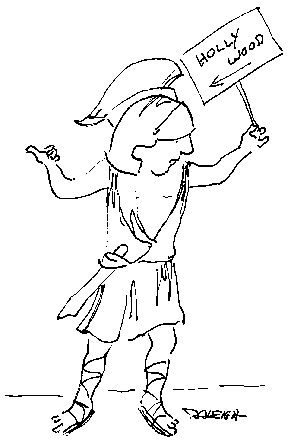 |
The Odyssey Film
By HENRY P. RALEIGH
ART TIMES July/August 2009
A curious twist on the odyssey tale is seen in the 1992 film “Roadside Prophets”. Seemingly a standard bike fare, two men race through the wasteland of Western deserts to find a casino called El Dorado, named for the mythical City of Gold. Their mission is to bury there the ashes of a friend who had been electrocuted playing a video game. On route they meet up with the hangovers of the 60’s Flower Children era— political radicals, New Agers, Eastern mystics and a couple of LSD dreams thrown in – Timothy Leary makes an appearance, even Arlo Guthrie. All of these encounters are satirically portrayed and as if in a sad allegory, empty remnants of a now meaningless past. The odyssey withers in a disappointment— no one is transformed, nothing is changed, the prophecies false, there is no El Dorado.
In recent years there have been a few odyssey films of sorts. “Wild Hogs” clumsily attempts it, a middleclass version featuring three ageing males distressed with their mundane lives — motorcycles, deserts and no dead bodies to liven it up. In a stretch “Superbad” and others like it might be viewed as teen odysseys overcoming obstacles in a quest to lose virginity. Odysseus, I figure, would be ashamed to have his name associated with these poor efforts. But there is, however, one that sticks charmingly to the classic odyssey story. While “Oh Brother, Where Art Thou” is a free adaptation — it’s not like Odysseus and his comrades sang a lot save for a sea chantey now and then — and pays homage to the basic story points. Led by George Clooney, and you must admit he makes a fine Odysseus, three escaped convicts set out on a desperate journey chasing after a treasure that doesn’t exist. Right off the bat we have what any genuine odyssey starts out with — a prophecy, this one intoned by a blind man who is a stand-in for a combination of the original Cassandra and Teiresias. And before you can rattle off the names of the Twelve Olympians, the three are seduced by the Siren’s song. One of the ladies, I guess for reasons of story economy, is a Circe who turns John Turturro into a toad rather than a swine, which is her usual custom. John Goodman sporting an eye-patch makes a dandy Polyphemus, the Cyclops and the KKK episode an adequate substitute for Odysseus’ harrowing sail through Scylla and Charydis. Everything winds up in a spectacular flood, reminding us of the dunking Odysseus suffered at the hands of Poseidon and a couple of thunderbolts, the hero returning to his Penelope and doing away with her suitor — not with arrows this time. It’s true, the film does lack corpses — a few dead cows maybe but that’s not clear.
For my money, “Oh, Brother” has it all over the re-doing of the Odyssey by Italian filmmakers in the 1954 “Ulysses”. I mean after all, Kirk Douglas alternately speaking in dubbed Italian and then in English? Fuit Ilium, I say, (something about Troy, it’s all I can remember from high school Latin).
